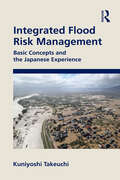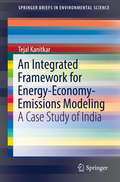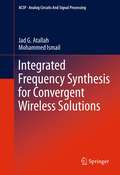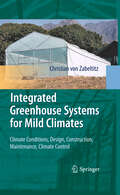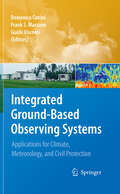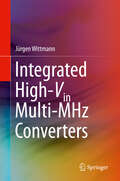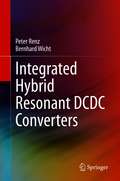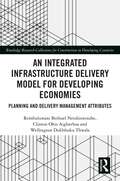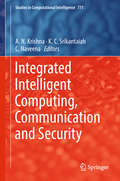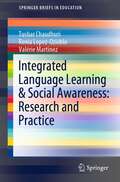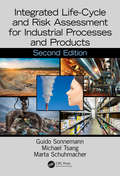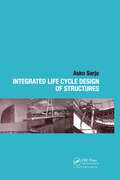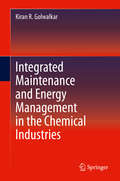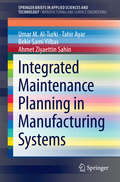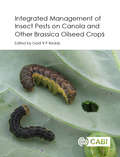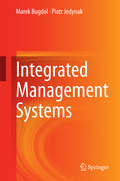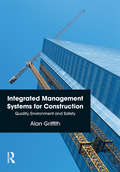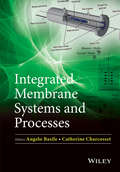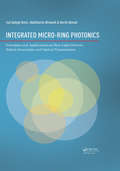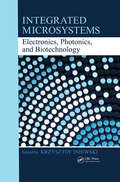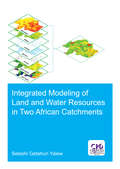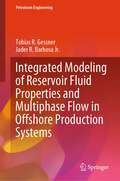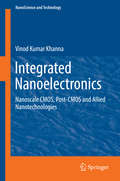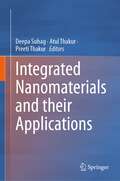- Table View
- List View
Integrated Flood Risk Management: Basic Concepts and the Japanese Experience
by Kuniyoshi TakeuchiThis book tackles the question of how we can manage flood-related disaster risks, such as from typhoons, monsoons, and torrential rain, which have been intensified by climate change and have generated unprecedented floods, landslides and debris flows worldwide. It presents recent conceptual developments in disasters, risk and resilience, and surveys UN policies on environment and development as well as disaster management. Sustainable and resilient development requires an integrated approach and human empowerment. Japan provides a useful example of effective flood management and disaster recovery in its current strategies for river and basin integrated flood management. Very few English-language books present up-to-date Japanese experiences for students and professionals in the context of global trends, relevant to a time of climate change and with global application. • Outlines an integrated approach to flood risk management in the context of UN initiatives • Details Japanese good practice developed through culture and the needs of a changing society Integrated Flood Risk Management is ideal for professionals working for environmental agencies, hydrologists and engineers, as well as students of disaster management and water resources development.
An Integrated Framework for Energy-Economy-Emissions Modeling: A Case Study of India (SpringerBriefs in Environmental Science)
by Tejal KanitkarThis book combines three different energy-economy-emissions modeling methodologies into one Integrated Modeling Framework (IMF) in an attempt to fill gaps in current modeling research as it applies to developing countries. Through the analysis of existing mathematical models, including large macro-economic models and technology-explicit energy models, the work proposes planning methodologies for developing countries that face challenges on their economy and infrastructure due to climate change. The three modeling methodologies discussed in the chapters are a decomposition analysis of trends in emissions intensity of GDP, linear programming techniques to determine optimum energy supply pathways given various resource and emissions constraints, and an input-output analysis to evaluate the impact of energy policies on income and equity. After a brief introduction to the history of the development of energy studies and the linkages between energy, economic, and environmental systems, the book delves into the component methodologies of the IMF and their intended outcomes. The decomposition analysis is intended to gauge the energy intensity of GDP and the structural composition of the economy to provide a basis on which scenarios are constructed in the following two methodologies. The linear programs are meant to develop a methodology to determine energy options under a variety of scenarios that capture the technical and economic characteristics of the power sector of developing countries. Lastly, the input-output analysis aims to build a methodology through which energy policy decisions can be understood and quantified to ensure the best possible impacts on developing economies and societies. Those who will be interested in this book include policy makers, academics, and students and professionals working on energy studies and energy-economy modeling.
Integrated Frequency Synthesis for Convergent Wireless Solutions
by Mohammed Ismail Jad G. AtallahThis book describes the design and implementation of an electronic subsystem called the frequency synthesizer, which is a very important building block for any wireless transceiver. The discussion includes several new techniques for the design of such a subsystem which include the usage modes of the wireless device, including its support for several leading-edge wireless standards. This new perspective for designing such a demanding subsystem is based on the fact that optimizing the performance of a complete system is not always achieved by optimizing the performance of its building blocks separately. This book provides "hands-on" examples of this sort of co-design of optimized subsystems, which can make the vision of an always-best-connected scenario a reality.
Integrated Greenhouse Systems for Mild Climates
by Christian Von ZabeltitzCrop production in greenhouses is a growing industry, especially in mild climates, and is very important for the population as a source of income and clean, fresh food. Greenhouses create optimal climate conditions for crop growth and protect crops from outside pests. At the same time greenhouse production increases water use efficiency and makes integrated production and protection (IPP) possible. This book provides technical instructions for practice (what to do and what not to do) and gives answers to the question: How to produce more clean crops and better quality with less water, less land and less pesticide. Suitable greenhouse constructions and their design, adapted to local climates in subtropical, tropical and arid regions and infrastructure conditions are presented. The necessary climate control measures - light transmittance, ventilation, cooling, heating, and CO2 enrichment - and physical measures for pest control, as well as methods for using solar energy to desalinate salty water are described. The results of theoretical research are transferred into methods for practical use, so that readers are equipped to solve their problems in practice as well as to get stimulation for further research and development.
Integrated Ground-Based Observing Systems
by Domenico Cimini Frank S. Marzano Guido ViscontiThe book is a collection of the lectures delivered during the 7th International Summer School on Atmospheric and Oceanic Sciences (ISSAOS) titled "Integrated Ground-Based Observing Systems Applications for Climate, Meteorology, and Civil Protection". Its aim is to contribute to the scientific understanding of basic concepts and applications of integrated ground-based observing systems. The first part describes the most common instrumentations showing their strengths and limitations. Furthermore, strategic plans for the deployment of an observation site are discussed along with an overview of techniques for integrating heterogeneous data. The second part introduces cutting-edge applications, including assimilation in numerical weather prediction, climate benchmarking, air quality monitoring and meteo/hydrological warnings.
Integrated High-Vin Multi-MHz Converters
by Jürgen WittmannThis book provides readers with guidelines for designing integrated multi-MHz-switching converters for input voltages/system supplies up to 50V or higher. Coverage includes converter theory, converter architectures, circuit design, efficiency, sizing of passives, technology aspects, etc. The author discusses new circuit designs, new architectures and new switching concepts, including dead-time control and soft-switching techniques that overcome current limitations of these converters. The discussion includes technology related issues and helps readers to choose the right technology for fast-switching converters. This book discusses benefits and drawbacks in terms of integration, size and cost, efficiency and complexity, and enables readers to make trade-offs in design, given different converter parameters.Describes a study for increasing switching frequencies up to 30 MHz at input voltages up to 50V or higher in the scaling of the size of switching converter passives;Analyzes various buck converter implementations and shows that a preference due to higher efficiency depends on the operating point, on the available switch technologies, and on the implementation of the high-side supply generation;Describes an efficiency model based on a four-phase model, which enables separation of loss causes and loss locations.
Integrated Hybrid Resonant DCDC Converters
by Peter Renz Bernhard WichtThis book provides a comprehensive, single-source on resonant switched-capacitor converters. It is written in the style of a handbook, with systematic guidelines, and includes implementation examples. The authors explore integrated hybrid resonant DCDC converters in order to achieve highly compact, energy efficient and cost-effective power management solutions in the growing fields of wearables and internet-of-things applications. They provide an introduction into hybrid converters as a new and promising converter class, which merges capacitive and inductive conversion concepts into one. Coverage ranges from fundamentals to implementation details, including topics such as power stage design, gate drive schemes, different control mechanisms for resonant operation and integrated passives.Introduces a new, multi-ratio resonant converter architecture, which enables lower switching frequencies and better passive component utilization;Discusses circuit block design for high efficiency of the power stage;Explores implementation details and concepts for integrated passives;Derives models, implements and compares to each other different control mechanisms.
An Integrated Infrastructure Delivery Model for Developing Economies: Planning and Delivery Management Attributes (Routledge Research Collections for Construction in Developing Countries)
by Rembuluwani Bethuel Netshiswinzhe Clinton Aigbavboa Wellington Didibhuku ThwalaThis book explores the attributes of an integrated model for infrastructure delivery as a means to achieve high impact investing, sustainable growth and development in a developing economy. An Integrated Infrastructure Delivery Model for Developing Economies: Planning and Delivery Management Attributes is premised on the understanding that one of the most significant barriers to efficient and effective infrastructure delivery is the nature and extent of fragmentation in the ways in which infrastructure projects are planned, designed, and delivered. Using a Delphi method, the research presented in this book examines the infrastructure delivery models and practices that have been employed in South Africa and other developing countries, and in doing so presents eight attributes for integrated infrastructure delivery. These are: (i) developing a common vision for the community, (ii) stakeholder participation, (iii) integrated project development and scoping, (iv) access to planning information, (v) cross-sectoral planning, (vi) integrated infrastructure master plans, (vii) statutory and regulatory compliance and (viii) integrated contractual frameworks. The book presents a practical model that can serve as a guide and a manual for project planning and development to achieve integrated infrastructure delivery in developing economies. The proposed model should serve as a framework to inform future planning and programming of infrastructure projects within the public sector space. Furthermore, the application of the model will help resolve the problems of fragmentation and lack of coordination in how infrastructure projects are planned and implemented. This book will be beneficial to infrastructure practitioners, policymakers, researchers and academics who pursue best practice models to improve the delivery and management of infrastructure.
Integrated Intelligent Computing, Communication and Security (Studies in Computational Intelligence #771)
by C Naveena K. C. Srikantaiah A. N. KrishnaThis book highlights the emerging field of intelligent computing and developing smart systems. It includes chapters discussing the outcome of challenging research related to distributed computing, smart machines and their security related research, and also covers next-generation communication techniques and the networking technologies that have the potential to build the future communication infrastructure. Bringing together computing, communications and other aspects of intelligent and smart computing, it contributes to developing a roadmap for future research on intelligent systems.
Integrated Language Learning & Social Awareness: Research and Practice (SpringerBriefs in Education)
by Tushar Chaudhuri Renia Lopez-Ozieblo Valérie MartinezThis book reports on and analyses the Integrated Language Learning & Social Awareness Project, a unique project in the field of Foreign Language Learning and Telecollaboration till now in the world. It takes the existing research on telecollaborative learning, content and language integrated learning and e-learning and combines them into one coherent concept in which language acquisition and enhancement takes place through task-led research on the specific issue of “Healthy Cities” by targeting language learners from around the world. The book delivers insights into the planning and the development of the project including collaborative task design and its underlying theoretical and research frameworks. It then goes on to reflect on how these underlying frameworks are developed further to broaden the existing paradigms of research in the field of telecollaborative language learning.
Integrated Life-Cycle and Risk Assessment for Industrial Processes and Products (Advanced Methods in Resource & Waste Management)
by Guido Sonnemann Michael Tsang Marta SchuhmacherLife-cycle assessment is a methodology used to evaluate the environmental impacts of a product, process, or service during its life cycle, and risk assessment is a tool to evaluate potential hazards to human health and the environment introduced by pollutant emissions. The United Nations Sustainable Development Goals call for, among other objectives, responsible consumption and production by decoupling environmental resource use and environmental impacts from economic growth and human well-being. Life-cycle assessment and risk assessment are both analytical system approaches that allow scientists and other decision makers to address these issues and objectives according to the current understanding of environmental mechanisms. This book is the first attempt to illustrate the existing interfaces between life-cycle assessment and risk assessment and to indicate options for further integration of both tools. The second edition: Focuses on sustainability Considers new developments in life-cycle assessment and environmental risk assessment over the last ten years at the international level Introduces broader concepts and discussions on integrative versus the complementary use of life-cycle and risk assessments Extends the scope of integrated life-cycle and risk assessments to critical raw materials Includes more case studies and discusses engineered nanomaterials Featuring contributions from leading experts, Integrated Life-Cycle and Risk Assessment for Industrial Processes and Products is a great reference for graduate students and professionals in environmental management and intends to catalyze communication between life-cycle assessment and risk assessment experts and scientists in academia, industry, and governmental agencies. The practical format of the book—illustrated with flowcharts, examples, exercises, and concrete applications—makes it a useful manual for analyzing situations and making decisions.
Integrated Life Cycle Design of Structures
by Asko SarjaTraditionally the process of design has concentrated on the construction phase itself, with the primary objective being to optimise efficiency and minimise costs during development and construction. With the move towards a more sustainable development comes the need for this short-term approach to be expanded to encompass the entire service life of the structure. This book describes how to optimise the service life of structures, through an optimum integrated life cycle design process. Sustainability and material performance issues are detailed. Integrated Life Cycle Design of Structures provides a comprehensive account of this rapidly emerging field. It is essential reading for civil and structural engineers, designers, architects, contractors, and clients.
Integrated Maintenance and Energy Management in the Chemical Industries
by Kiran R. GolwalkarThis book provides guidelines to ensure a safe and smooth running chemical production plant. It presents in detail such important considerations as selection of proper technology with efficient machinery (for a new plant) or expansion / diversification of existing plants for manufacture of more products for safe and pollution-free operation.This book also provides guidelines for improved plant layout, and selection of raw materials to reduce pre-processing costs prior to feeding to process units. The book further examines procuring better inputs (such as catalysts, filter cloths, tower internals etc) required for smooth plant operation and better product quality for client satisfaction, enhanced process control through suitable instrumentation, and preventive maintenance.Typical conflicts arising in production units due to different priorities among sales departments, purchasing departments, production engineers, and maintenance engineers are addressed. The book also suggests methods to reduce the loss of energy during start up and shutdowns, increase equipment life, and prevent environmental pollution.Case studies are included in appropriate chapters.
Integrated Maintenance Planning in Manufacturing Systems
by Umar M. Al-Turki Tahir Ayar Bekir Sami Yilbas Ahmet Ziyaettin SahinThis book introduces the concept of integrated planning for maintenance and production taken into account quality and safety for high global socio-economic impact. It provides insight into the planning process at a global level starting from the business level and ending with the operational level where the plan is implemented and controlled.
Integrated management of Insect Pests on Canola and other Brassica Oilseed Crops
by Harit K Bal Ronald E Batallas Tulsi Bhardwaj James D Blande Dhana Raj Boina G David Buntin Randall Brandt Hector Cárcamo Surendra Dara Tim J Dumonceaux Robert H Elliott Maya Evenden Yaghoub Fathipour Kevin D Floate John Gavloski Kristopher L Giles Larry Grenkow Parwinder Grewal Rebecca H Hallett Matthew P. Hill Vincent A Hervet Sari J. Himanen Heikki M.T. Hokkanen Jarmo K Holopainen Prashant Jha Peter Mason Janet J Knodel Tao Li Sarina Macfadyen Ingeborg Menzler-Hokkanen Mohammad Ali Mirhosseini Christine Noronha Chrystel Olivier Francisco Rubén Badenes-Pérez S. Jesu Rajan Tom Royer Muhammad Sarwar Barbara Sharanowski Govinda Shrestha Juliana Soroka Rajagopalbabu Srinivasan Raj Kumar Thakur Sally Vail Leyun Wang R W Wanigasekara Chaminda De Weeraddana Tyler J Wist Zi-Hua ZhaoThis book comprehensively reviews current pest management practices and explores novel integrated pest management strategies in Brassica oilseed crops. It is essential reading for pest management practitioners and researchers working on pest management in canola and other Brassica crops worldwide. Canola, mustard, camelina and crambe are the most important oilseed crops in the world. Canola is the second largest oilseed crop in the world providing 13% of the world's supply. Seeds of these species commonly contain 40% or more oil and produce meals with 35 to 40% protein. However, its production has declined significantly in recent years due to insect pest problems. The canola pest complexes are responsible for high insecticide applications on canola. Many growers rely on calendar-based spraying schedules for insecticide applications. The diamondback moth Plutella xylostella and flea beetles Phyllotreta spp. (P. cruciferae and P. striolata)cause serious damage to canola. In the Northern Great Plains, USA, for instance, P. xylostella is now recorded everywhere that canola is grown. Severe damage to canola plants can be caused by overwintering populations of flea beetles feeding on newly emerged seedlings. Cabbage seed pod weevil (Ceutorhynchus obstrictus), swede midge (Contarinia nasturtii), and tarnished plant bug (Lygus lineolaris) are also severe pests on canola. Minor pests include aphids (cabbage aphid, Brevicoryne brassicae and turnip aphid, Hyadaphis erysimi) and grasshopper, Melanoplus sanguinipes. This book: · is the only single compiled source of information on integrated management of canola and other Brassica oilseed pests · presents the biology and management of all the major and minor pests of Brassica oilseed crops · is an essential source of information for applied entomologists, crop protection researchers, extension agents and stakeholders
Integrated Management of Insect Pests on Canola and Other Brassica Oilseed Crops
by Gadi V.P. ReddyThis book comprehensively reviews current pest management practices and explores novel integrated pest management strategies in Brassica oilseed crops. It is essential reading for pest management practitioners and researchers working on pest management in canola and other Brassica crops worldwide. Canola, mustard, camelina and crambe are the most important oilseed crops in the world. Canola is the second largest oilseed crop in the world providing 13% of the world's supply. Seeds of these species commonly contain 40% or more oil and produce meals with 35 to 40% protein. However, its production has declined significantly in recent years due to insect pest problems. The canola pest complexes are responsible for high insecticide applications on canola. Many growers rely on calendar-based spraying schedules for insecticide applications. The diamondback moth Plutella xylostella and flea beetles Phyllotreta spp. (P. cruciferae and P. striolata)cause serious damage to canola. In the Northern Great Plains, USA, for instance, P. xylostella is now recorded everywhere that canola is grown. Severe damage to canola plants can be caused by overwintering populations of flea beetles feeding on newly emerged seedlings. Cabbage seed pod weevil (Ceutorhynchus obstrictus), swede midge (Contarinia nasturtii), and tarnished plant bug (Lygus lineolaris) are also severe pests on canola. Minor pests include aphids (cabbage aphid, Brevicoryne brassicae and turnip aphid, Hyadaphis erysimi) and grasshopper, Melanoplus sanguinipes. This book: #65533; is the only single compiled source of information on integrated management of canola and other Brassica oilseed pests #65533; presents the biology and management of all the major and minor pests of Brassica oilseed crops #65533; is an essential source of information for applied entomologists, crop protection researchers, extension agents and stakeholders
Integrated Management Systems
by Marek Bugdol Piotr JedynakExamining the challenges of integrated management, this book explores the importance and potential benefits of using an integrated approach as a cross-functional concept of management. It covers not only standardized management systems (e. g. International Organization for Standardization), but also models of self-assessment, as well as different types of integration. Furthermore, it demonstrates how processes and systems can be integrated, and how management efficiency can be increased. The major part of this book focuses on management concepts which use integration as a key tool of management processes (e. g. the systematic approach, supply chain management, virtual and network organizations, processes management and total quality management). Case studies, illustrations, and tables are also provided to exemplify and illuminate the content, as well as examples of successful and failed integrations. Providing a particularly useful resource to managers and specialists involved in the improvement of organizational performance, this book is also intended for top managers, functional managers, project managers, specialists, consultants, and those who wish to improve the efficiency and effectiveness of management. It also offers a helpful guide to academics and students interested in quality and risk management.
Integrated Management Systems for Construction: Quality, Environment and Safety
by Alan GriffithIntegrated management systems (IMS) are an innovative way of handling the plethora of management functions and procedures that are applied throughout major construction projects. Contracting companies use management systems to shape and define the corporate arrangement of their business activities, translating these into operational procedures for application to the construction projects they undertake. The management of quality, environment, and safety are at the forefront of systems evolution where the integration of these traditionally independent and dedicated standards-based and process-orientated systems can provide the potential to deliver greater organisational efficiency and effectiveness. This is the first textbook to cover each of the international standards for quality, safety and environment (ISO9000, ISO14001 and ISO18001) and to discuss integrating them. This book provides a detailed yet accessible text to support the study of quality, environment, and safety management systems on professionally accredited undergraduate courses throughout the built environment and for advanced postgraduate courses in construction, project, and engineering management. It is also an indispensible reference for construction professionals working for principal contractors, subcontractors and construction industry supply chain organisations.
Integrated Membrane Systems and Processes
by Angelo Basile Catherine CharcossetThe book examines the possibility of integrating different membrane unit operations (microfiltration, ultrafiltration, nanofiltration, reverse osmosis, electrodialysis and gas separation) in the same industrial cycle or in combination with conventional separation systems. It gives careful analysis of the technical aspects, and the possible fields of industrial development. The book reviews many original solutions in water desalination, agro-food productions and wastewater treatments, highlighting the advantages achievable in terms of product quality, compactness, rationalization and optimization of productive cycles, reduction of environmental impact and energy saving. Also included are examples of membrane reactors and their integration with a fuel cell; polymeric membranes in the integrated gasification combined cycle power plants; integrating a membrane reformer into a solar system; and potential application of membrane integrated systems in the fusion reactor fuel cycle. With detailed analysis and broad coverage, the book is divided into two sections: Bio-applications and Inorganic Applications.
Integrated Micro-Ring Photonics: Principles and Applications as Slow Light Devices, Soliton Generation and Optical Transmission
by Iraj Sadegh Amiri Abdolkarim Afroozeh Harith AhmadMicro-ring resonators (MRRs) are employed to generate signals used for optical communication applications, where they can be integrated in a single system. These structures are ideal candidates for very large-scale integrated (VLSI) photonic circuits, since they provide a wide range of optical signal processing functions while being ultra-compact. Soliton pulses have sufficient stability for preservation of their shape and velocity. Technological progress in fields such as tunable narrow band laser systems, multiple transmission, and MRR systems constitute a base for the development of new transmission techniques. Controlling the speed of a light signal has many potential applications in fiber optic communication and quantum computing. The slow light effect has many important applications and is a key technology for all optical networks such as optical signal processing. Generation of slow light in MRRs is based on the nonlinear optical fibers. Slow light can be generated within the micro-ring devices, which will be able to be used with the mobile telephone. Therefore, the message can be kept encrypted via quantum cryptography. Thus perfect security in a mobile telephone network is plausible. This research study involves both numerical experiments and theoretical work based on MRRs for secured communication.
Integrated Microsystems: Electronics, Photonics, and Biotechnology (Devices, Circuits, and Systems)
by Iniewski KrzysztofAs rapid technological developments occur in electronics, photonics, mechanics, chemistry, and biology, the demand for portable, lightweight integrated microsystems is relentless. These devices are getting exponentially smaller, increasingly used in everything from video games, hearing aids, and pacemakers to more intricate biomedical engineering and military applications. Edited by Kris Iniewski, a revolutionary in the field of advanced semiconductor materials, Integrated Microsystems: Electronics, Photonics, and Biotechnology focuses on techniques for optimized design and fabrication of these intelligent miniaturized devices and systems. Composed of contributions from experts in academia and industry around the world, this reference covers processes compatible with CMOS integrated circuits, which combine computation, communications, sensing, and actuation capabilities. Light on math and physics, with a greater emphasis on microsystem design and configuration and electrical engineering, this book is organized in three sections—Microelectronics and Biosystems, Photonics and Imaging, and Biotechnology and MEMs. It addresses key topics, including physical and chemical sensing, imaging, smart actuation, and data fusion and management. Using tables, figures, and equations to help illustrate concepts, contributors examine and explain the potential of emerging applications for areas including biology, nanotechnology, micro-electromechanical systems (MEMS), microfluidics, and photonics.
Integrated Modeling of Land and Water Resources in Two African Catchments
by Seleshi Getahun YalewDemand for land and water for agriculture, urbanization, irrigation, hydropower, and industrialization is increasing to meet the demands of growing populations and of growing economies. However, changes in land and water resources are often studied separately. A better representation of the interaction between land-use change and its drivers on the one hand and water resources on the other is imperative for sustainable environmental management. This research investigates and develops spatial analysis methods and tools for the quantification of dynamic feedbacks between land-use change and water resources, by focusing on case study catchments in Ethiopia and South Africa. Furthermore, the research investigates methods for analysing land-use suitability and modelling land-use change. Results show that major changes in land-use have been observed in the past two to three decades in the study catchments. Model representation of the interaction between land-use change and water resources shows that changes in land-use influence hydrologic responses. These influences are especially pronounced during high- and low-flow seasons. Likewise, hydrologic processes and water resources availability influence land-use suitability and hence land-use change responses. Accounting for the dynamic feedback between land-use and hydrology thus produces improved knowledge that can better inform integrated natural resources management.
Integrated Modeling of Reservoir Fluid Properties and Multiphase Flow in Offshore Production Systems (Petroleum Engineering)
by Tobias R. Gessner Jader R. Barbosa Jr.The book is intended for practicing engineers in the oil industry, researchers, and graduate students interested in designing and simulating offshore hydrocarbon production systems. It approaches offshore oil production systems from an integrated perspective that combines the modeling of thermophysical properties of reservoir fluids and their flow as a multiphase mixture in wellbores, flow lines, and risers.The first part of the book presents an internally consistent method to compute the critical parameters and acentric factor of Single Carbon Number (SCN) fractions of petroleum mixtures using state-of-the-art multivariate fitting techniques. The procedure is illustrated and validated using flash and differential liberation data from actual field samples. In the second part of the book, mechanistic multiphase flow models are discussed in light of their ability to predict the pressure, temperature, and phase holdup of production fluids in wellbores, flow lines, and risers. Multivariate fitting procedures are again applied to evaluate the sensitivity of the results with respect to closure relationship parameters, such as slug body gas holdup, wall shear stress, and wall roughness in pipelines and production tubing. Finally, the modeling framework is validated using actual field data from offshore production wells.
Integrated Nanoelectronics
by Vinod Kumar KhannaKeeping nanoelectronics in focus, this book looks at interrelated fields namely nanomagnetics, nanophotonics, nanomechanics and nanobiotechnology, that go hand-in-hand or are likely to be utilized in future in various ways for backing up or strengthening nanoelectronics. Complementary nanosciences refer to the alternative nanosciences that can be combined with nanoelectronics. The book brings students and researchers from multiple disciplines (and therefore with disparate levels of knowledge, and, more importantly, lacunae in this knowledge) together and to expose them to the essentials of integrative nanosciences. The central idea is that the five identified disciplines overlap significantly and arguably cohere into one fundamental nanotechnology discipline. The book caters to interdisciplinary readership in contrast to many of the existing nanotechnology related books that relate to a specific discipline. The book lays special emphasis on nanoelectronics since this field has advanced most rapidly amongst all the nanotechnology disciplines and with significant commercial pervasion. In view of the significant impact that nanotechnology is predicted to have on society, the topics and their interrelationship in this book are of considerable interest and immense value to students, professional engineers, and reserachers.
Integrated Nanomaterials and their Applications
by Deepa Suhag Atul Thakur Preeti ThakurThe book provides an overview of different nanoparticles, their classification, and their applications in healthcare, food sciences, environmental sciences, and agricultural sciences. The introductory chapters discuss different types of nanoparticles, their types, and their structural properties. The subsequent chapter examines factors that influence the biocompatibility and toxicity of NPs for the safe and sustainable development of emerging nanoparticles. The chapter systematically reviews the nanoparticle-based contrast agents employed in most common biomedical imaging modalities. The book further examines the applications of advanced nanoparticle design that are utilized for both non-personalized and precision applications for improving precision therapies. The book provides a comprehensive update on nanoparticles’ toxic effects, the factors underlying their toxicity, and the mechanisms by which toxicity is induced. This book is an ideal guide for researchers and students interested in understanding the applications of nanoparticles in biomedical sciences and the healthcare sector.
